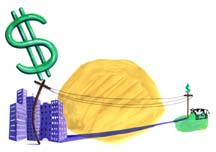"Ten cents a minute!" "Eight cents a minute!" Everywhere you look, it seems, someone is offering a lower rate on phone calls. Lower, yes; but whether these prices truly reflect the cost of service is a different story. In a discussion at Wharton earlier this fall entitled "Populism, the Median Voter and Telephone Regulation in the U.S.,"
The Telecommunications Act of 1996 was supposed to open up the market and encourage competition in the telephone industry, but it did little to change the regulatory climate. The act required states to permit new entrants in the local service market; however, it continued to force local firms to price their phone service below cost in many rural areas but above cost in urban areas and to business customers. Regulators kept monthly residential rates, particularly in these rural or less populated areas, well below the cost of providing the service. This was done in the name of the "Universal Service Policy," which, they claimed, would ensure that everyone had access regardless of income.
Estimates of the costs of phone service vary; the lack of true competition has kept these costs from being transparent. Industry players have only recently been making some of these costs known. But even from the rough figures, Crandall said, it’s clear that customers with the lowest cost of service — typically those in densely populated areas with shorter lines — have been paying the highest prices. Customers in rural areas, where the line cost may be as much as five times more, have paid prices far below cost.
"Maintenance of low access rates were justified as necessary for universality," Crandall said. "But the residential demand for access is in fact very price inelastic; it’s long-distance rates that are more price elastic." Even if repricing were to be implemented and rates went toward cost, the poorest customers would only be paying a very small percentage of their income to have line access. He noted that other utilities, such as gas, water and electricity, do not have such cross-subsidies imposed on them; yet access is still universal.
The regulatory policy was supposed to transfer rents between low-income and high-income areas, but what occurred was mainly an urban-to-rural shift. The distorted rate structure, Crandall argued, might not in fact reflect a populist policy at all: "Keeping long distance rates high and local rates low is beneficial to the median voter. Because long distance calling is highly skewed, a large share of consumers benefit from using high long-distance rates to pay for local services." Such voter-oriented policymaking was evident, said Crandall, whether the regulators were appointed or elected.
Newer technologies, such as Internet telephony and increased wireless phone usage, are now threatening the status quo. As competition heats up, Crandall said, the subsidies would likely have to be paid to carriers or subscribers from taxes on telecommunications services; an intrastate tax would cost the economy much less than an interstate tax. Since state regulators have no authority over the wireless industry, it will be interesting to see how these new telecom vehicles play out in the long run.
Gerald Faulhaber, professor of public policy and management at Wharton and a former manager at Bell Labs and AT&T, attended Crandall’s talk and had a slightly different take on the subject. "As I see it, the big subsidy isn’t so much urban to rural, but rather long distance to local," said Faulhaber. "Yes, it’s politically driven — in the old days, the many people who used local calling could outvote those who used long-distance. That’s why there are lower prices for local calls. Over time, as society became more mobile, more people started calling long distance. The median voter these days probably does make long distance calls. Thus, long distance prices have recently come down."
Faulhaber envisioned two possibilities for the telecom landscape in five to eight years. "We’ll either have a big, fat data pipe coming into our house — a sort of souped-up cable that transmits voice, video, high-speed Internet, and so forth — or we’ll see a tremendous increase in wireless usage. It could be broadband: We might each get our own chunk of radio frequency." Europe, he noted, is already using wireless technology in a big way; unlike the United States, countries there had long been dogged by a more expensive, cumbersome wired infrastructure and were able to converge on a single wireless standard.
Nonetheless, Faulhaber emphasized that Crandall’s basic point would remain valid no matter what technology takes hold. Political pressure would still be exerted to extend service to rural and other underserved areas. "Old technologies have a way of sticking around. But even if wireline becomes obsolete, you’ll still see the same debate; it’ll just be the haves vs. the have-nots of broadband or cellular technology instead of the wireline world."



